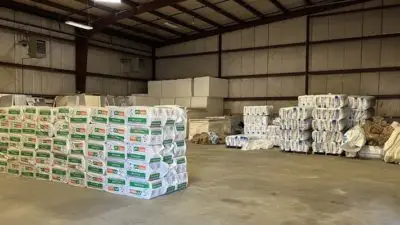When we think of landfills, items like plastic water bottles, plastic bags, and straws come to mind, but what about clothing? According to the U.S. Environmental Protection Agency (EPA), “the main source of textiles in municipal solid waste is discarded clothing.” Other sources include furniture, footwear, sheets, and towels.
The EPA estimates that the U.S. generates an average of 25 billion pounds of textiles per year, with 85% going to landfills.
Facts about textile generation, recycling, and waste*
- Textile waste accounts for 5% of landfill space
- The generation of textiles in 2018 was 17 million tons, representing 5.8% of total municipal solid waste generation that year
- The recycling rate for all textiles was 14.7% in 2018, with 2.5 million tons recycled
- 1.5 million tons of towels, sheets, and pillowcases were generated in 2018, with 240,000 tons recycled at a 15.8% recycling rate
*Numbers provided by the EPA and the University of Colorado
Make your closet green
Just as you drink from a reusable water bottle or bring a reusable bag to the store, you can also make habit changes regarding the sustainability of your closet and how you approach and dispose of textiles from your home.
- Be thoughtful about your clothing choices (fast fashion vs. slow fashion)
- Trade, sell, and donate your used clothing
- Donate to item-specific charities (organizations who need certain clothing items for specific groups)
- Repurpose your clothing (think art projects or turning old t-shirts into cleaning rags)
- Go thrifting or learn about clothing brands before you buy
- Properly care for your clothes so that they last
Buy from sustainable brands
If you want to shop sustainably, there are many companies out there that are using recycled fabrics, making their clothes sustainably, supporting green community efforts, and more. Here are some sustainable clothing brands that are making efforts to go green and take care of our planet.
- Outerknown transformed fishnets into a nylon fabric that it uses to make jackets, watchbands, and flip-flops
- Vuori has a collection of workout and casual wear designed with recycled fabrics
- Patagonia was named one of the United Nation’s 2019 Champions of the Earth
- Levi’s pledges to use 100% sustainably-sourced cotton by 2025 and has driven earth-friendly initiatives like WaterLess and SecondHand
- ADAY will recycle its own items for you when you’re done and uses a stretchy fabric they make from recycled water bottles
- Reformation is carbon neutral and educates customers about how much CO2, water, and waste they’re saving
- RE/DONE has diverted 100,000 garments from landfills since its launch, by redesigning and reselling them
- Asket is working toward 100% traceability from farm to garment so that customers know exactly how their clothing is made
- All Birds uses eucalyptus trees, recycled plastic bottles, recycled nylon, and sugarcane to make their shoes, in addition to wool
- Older Brother uses natural ingredients like chaga mushrooms and sea kelp to dye their clothes
Recycle your denim
Did you know that authentic denim made from cotton (at least 90%) is a sustainable fiber? We’re talking pants, shirts, skirts, and more! Denim can be recycled and transformed into building insulation, pet bed inserts, and thermal insulation used in sustainable food and pharmaceutical packaging – which means it doesn’t end up in landfills! (Interested in learning more about the benefits of recycled denim insulation? Click here.)
Recycle your jeans through the mail with Zappos here or go to your local Levi’s or Madewell stores and drop them in the box.
What we wear has everything to do with how sustainable we’re living. Small changes make a big difference and one step at a time, we will make our communities greener.
Looking for more ways to be sustainable at home? Check out our HomeWorks Energy website for more ideas.








